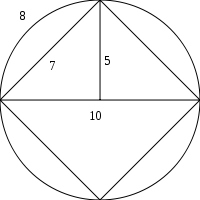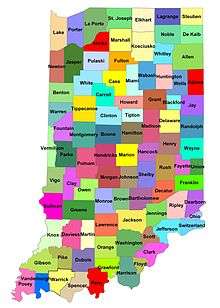Indiana Pi Bill
| Part of a series of articles on the |
| mathematical constant π |
|---|
 |
| Uses |
| Properties |
| Value |
| People |
| History |
| In culture |
| Related topics |
The Indiana Pi Bill is the popular name for bill #246 of the 1897 sitting of the Indiana General Assembly, one of the most notorious attempts to establish mathematical truth by legislative fiat. Despite its name, the main result claimed by the bill is a method to square the circle, rather than to establish a certain value for the mathematical constant π, the ratio of the circumference of a circle to its diameter. However, the bill does imply various incorrect values of π, such as 3.2.
The bill never became law, due to the intervention of Professor C. A. Waldo of Purdue University, who happened to be present in the legislature on the day it went up for a vote.
The impossibility of squaring the circle using only compass and straightedge constructions, suspected since ancient times, was rigorously proven in 1882 by Ferdinand von Lindemann. Better approximations of π than those implied by the bill have been known since ancient times.
Legislative history
In 1894, Indiana physician and amateur mathematician Edward J. Goodwin (ca. 1825–1902[1]) believed that he had discovered a correct way of squaring the circle.[2] He proposed a bill to Indiana Representative Taylor I. Record, which Record introduced in the House under the long title "A Bill for an act introducing a new mathematical truth and offered as a contribution to education to be used only by the State of Indiana free of cost by paying any royalties whatever on the same, provided it is accepted and adopted by the official action of the Legislature of 1897".
The text of the bill consists of a series of mathematical claims (detailed below), followed by a recitation of Goodwin's previous accomplishments:
"... his solutions of the trisection of the angle, doubling the cube and quadrature of the circle having been already accepted as contributions to science by the American Mathematical Monthly ... And be it remembered that these noted problems had been long since given up by scientific bodies as unsolvable mysteries and above man's ability to comprehend."
Goodwin's "solutions" were indeed published in the American Mathematical Monthly, though with a disclaimer of 'published by request of the author'.[3]
Upon its introduction in the Indiana House of Representatives, the bill's language and topic occasioned confusion among the membership; a member from Bloomington proposed that it be referred to the Finance Committee, but the Speaker accepted another member's recommendation to refer the bill to the Committee on Swamplands, where the bill could "find a deserved grave".[4]:385 It was transferred to the Committee on Education, which reported favorably;[5] following a motion to suspend the rules, the bill passed on February 6,[4]:390 without a dissenting vote.[5] The news of the bill occasioned an alarmed response from Der Tägliche Telegraph, a German-language newspaper in Indianapolis, which viewed the event with significantly less favor than its English-speaking competitors.[4]:385 As this debate concluded, Purdue University Professor C. A. Waldo arrived in Indianapolis to secure the annual appropriation for the Indiana Academy of Science. An assemblyman handed him the bill, offering to introduce him to the genius who wrote it. He declined, saying that he already met as many crazy people as he cared to.[5]
When it reached the Indiana Senate, the bill was not treated so kindly, for Waldo had coached the senators previously. The committee to which it had been assigned reported it unfavorably, and the Senate tabled it on February 12;[4]:386 it was nearly passed, but opinion changed when one senator observed that the General Assembly lacked the power to define mathematical truth.[4]:391 Influencing some of the senators was a report that major newspapers, such as the Chicago Tribune, had begun to ridicule the situation.[4]:390
According to the Indianapolis News article of February 13:
...the bill was brought up and made fun of. The Senators made bad puns about it, ridiculed it and laughed over it. The fun lasted half an hour. Senator Hubbell said that it was not meet for the Senate, which was costing the State $250 a day, to waste its time in such frivolity. He said that in reading the leading newspapers of Chicago and the East, he found that the Indiana State Legislature had laid itself open to ridicule by the action already taken on the bill. He thought consideration of such a proposition was not dignified or worthy of the Senate. He moved the indefinite postponement of the bill, and the motion carried.[6]
Mathematics
Approximation of π

Although the bill has become known as the "Pi Bill", its text does not mention the name "pi" at all, and Goodwin appears to have thought of the ratio between the circumference and diameter of a circle as distinctly secondary to his main aim of squaring the circle. Towards the end of Section 2 appears the following passage:
"Furthermore, it has revealed the ratio of the chord and arc of ninety degrees, which is as seven to eight, and also the ratio of the diagonal and one side of a square which is as ten to seven, disclosing the fourth important fact, that the ratio of the diameter and circumference is as five-fourths to four[.]"[7]
This comes close to an explicit claim that  , and that
, and that  .
.
This quotation is often read as three mutually incompatible assertions, but they fit together well if the statement about √2 is taken to be about the inscribed square (with the circle's diameter as diagonal) rather than the square on the radius (with the chord of 90° as diagonal). Together they describe the circle shown in the figure, whose diameter is 10 and circumference is 32; the chord of 90° is taken to be 7. Both of the values 7 and 32 are within a few percent of the true lengths for a diameter-10 circle (which does not justify Goodwin's presentation of them as exact). The circumference should be nearer to 31.4159 and the diagonal "7" should be the square root of 50 (=25+25), or nearer to 7.071.
Area of the circle
Goodwin's main goal was not to measure lengths in the circle but to square it, which he interpreted literally as finding a square with the same area as the circle. He knew that Archimedes' formula for the area of a circle, which calls for multiplying the diameter by one fourth of the circumference, is not considered a solution to the ancient problem of squaring the circle. This is because the problem is to construct the area using compass and straightedge only, and Archimedes did not give a method for constructing a straight line with the same length as the circumference. Goodwin was clearly unaware of this central requirement; he believed that the problem with the Archimedean formula is that it gives wrong numerical results, and that a solution of the ancient problem should consist of replacing it with a "correct" formula. In the bill he proposed, without argument, his own method:
"It has been found that a circular area is to the square on a line equal to the quadrant of the circumference, as the area of an equilateral rectangle is to the square on one side."[7]
This appears needlessly convoluted, as an "equilateral rectangle" is, by definition, a square. In the rest of the bill, however, it is clear that the assertion is simply that the area of a circle is the same as that of a square with the same perimeter. For example, right after the above quote the bill goes on to say:
"The diameter employed as the linear unit according to the present rule in computing the circle's area is entirely wrong, as it represents the circle's area one and one-fifth times the area of a square whose perimeter is equal to the circumference of the circle."
In the model circle above, the Archimedean area (accepting Goodwin's values for the circumference and diameter) would be 80, whereas Goodwin's proposed rule leads to an area of 64. Now, 80 exceeds 64 by one fifth of 80, and Goodwin appears to confuse 64 = 80×(1−1⁄5) with 80 = 64×(1+1⁄5), an approximation that works only for fractions much smaller than 1⁄5.
The area found by Goodwin's rule is π⁄4 times the true area of the circle, which in many accounts of the Pi Bill is interpreted as a claim that π = 4. However, there is no internal evidence in the bill that Goodwin intended to make such a claim; on the contrary, he repeatedly denies that the area of the circle has anything to do with its diameter.
The relative area error of 1−π⁄4 works out to about 21 percent, which is much more grave than the approximations of the lengths in the model circle of the previous section. It is unknown what made Goodwin believe that his rule could be correct. In general, figures with identical perimeters do not have identical area (see isoperimetry); the typical demonstration of this fact is to compare a long thin shape with a small enclosed area (the area approaching zero as the width decreases) to one of the same perimeter that is approximately as tall as it is wide (the area approaching the square of the width), obviously of much greater area.
Notes
- ↑ Dudley 1992, p. 195, citing an obituary
- ↑ Edward J. Goodwin (July 1894) "Quadrature of the circle," American Mathematical Monthly, 1(7): 246–248.
- See: Purdue Agricultural Economics.
- Reprinted in: Lennart Berggren, Jonathan Borwein, and Peter Borwein, Pi: A Source Book, 3rd ed. (New York, New York: Springer-Verlag, 2004), page 230.
- See also: Edward J. Goodwin (1895) "(A) The trisection of an angle; (B) Duplication of the cube," American Mathematical Monthly, 2: 337.
- ↑ "Clearing the Misunderstanding Re My April Fool's `Joke'", math.rutgers.edu.
- 1 2 3 4 5 6 Hallerburg, Arthur E. "House Bill No. 246 Revisited". Proceedings of the Indiana Academy of Science 84 (1974): 374–399.
- 1 2 3 Indiana pi story at a Purdue server
- ↑ http://www.agecon.purdue.edu/crd/Localgov/Second%20Level%20pages/Indiana_Pi_Story.htm
- 1 2 Text of the bill
References
- "Indiana's squared circle" by Arthur E. Hallerberg (Mathematics Magazine, vol. 50 (1977), pp. 136–140) gives a good account of the bill.
- David Singmaster, in "The legal values of pi" (Mathematical Intelligencer, vol. 7 (1985), pp. 69–72) finds seven different values of pi implied in Goodwin's work.
- Petr Beckmann, A History of π. St. Martin's Press; 1971.
- Mathematics: From the Birth of Numbers, published by W. W. Norton in 1997 (ISBN 039304002X ), by Jan Gullberg
- Dudley, Underwood (1992), "Legislating Pi", Mathematical cranks, MAA spectrum, Cambridge University Press, pp. 192 sq., ISBN 0-88385-507-0
External links
- Full text of the bill
- Indiana Pi narrative about the near-passing of the bill
- The Straight Dope - Did a state legislature once pass a law saying pi equals 3?
- Alabama Changes the Value of Pi related hoax
| |||||||||||||||||||||||||||||||||||||||||


